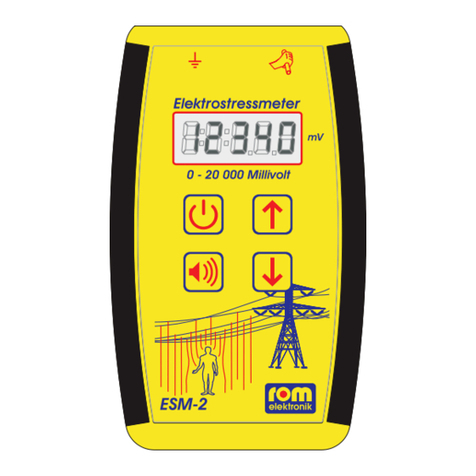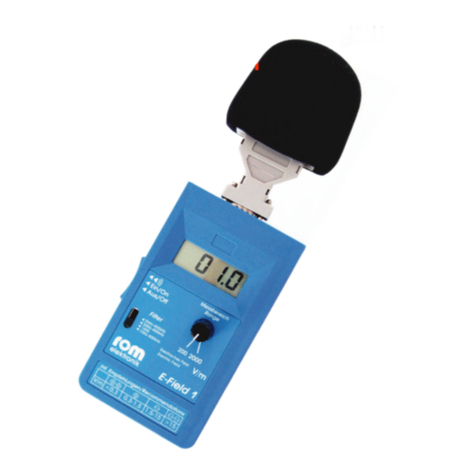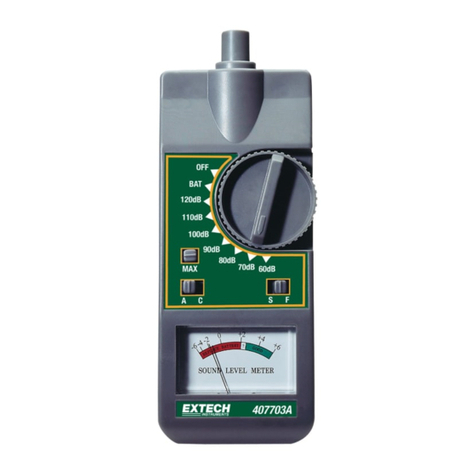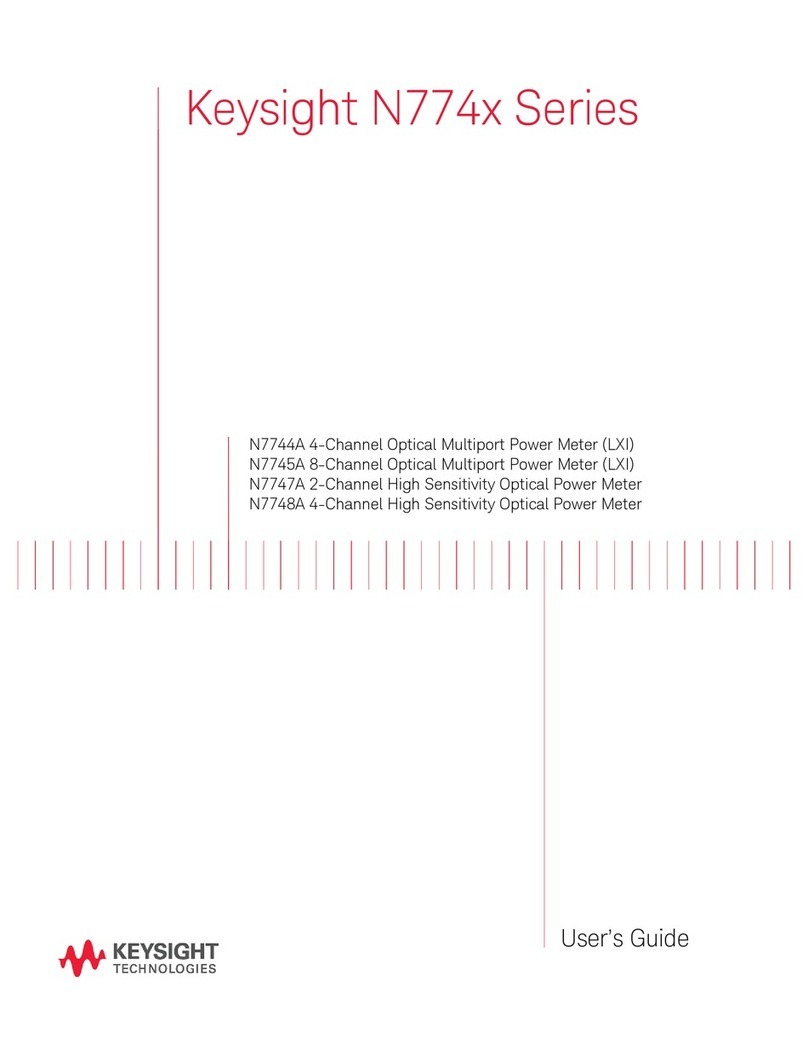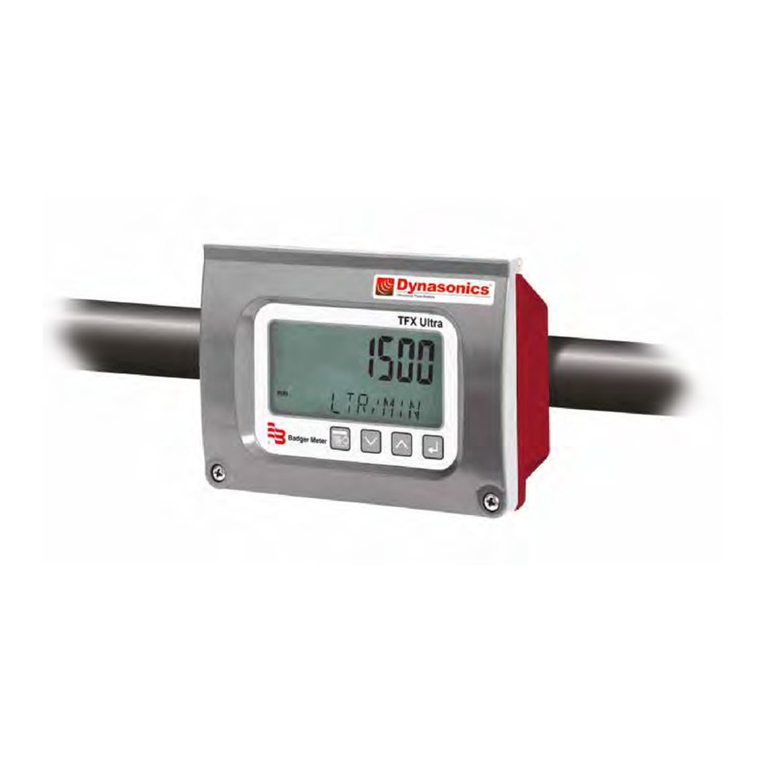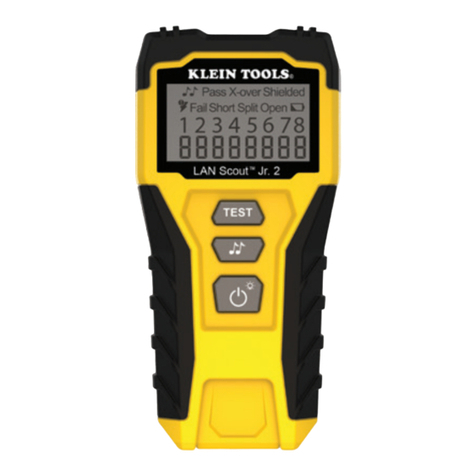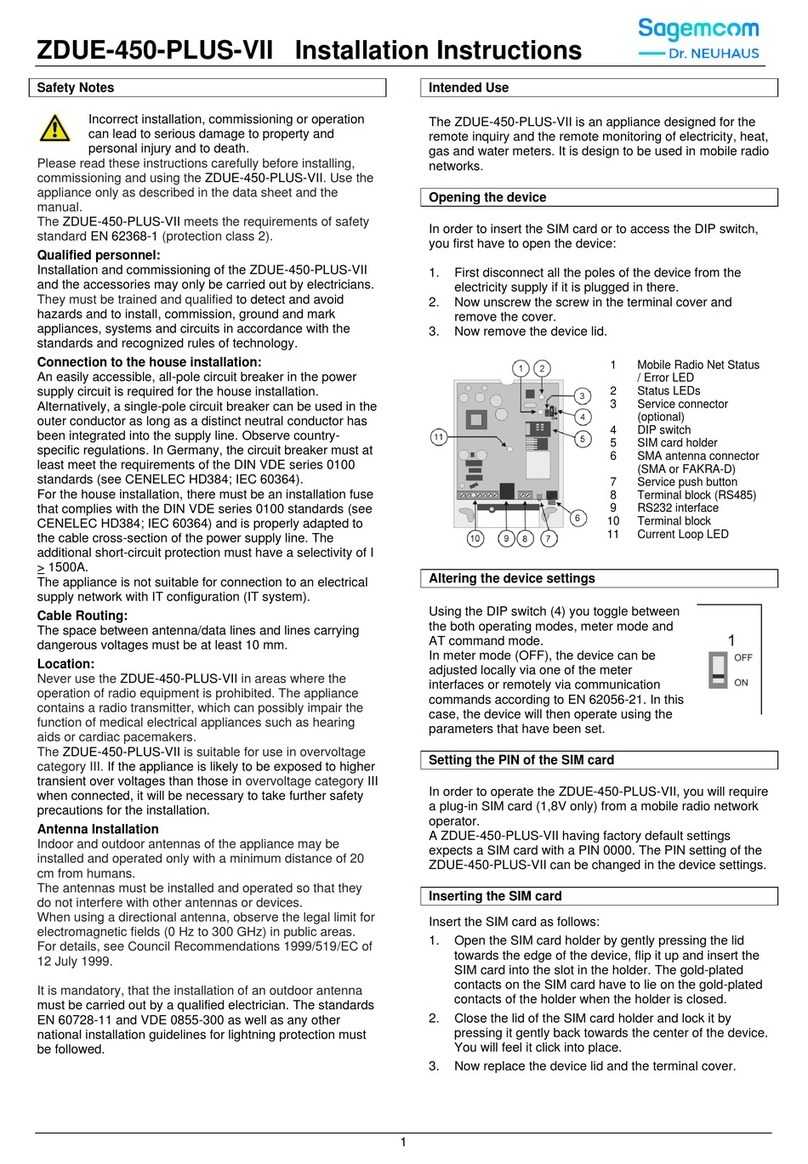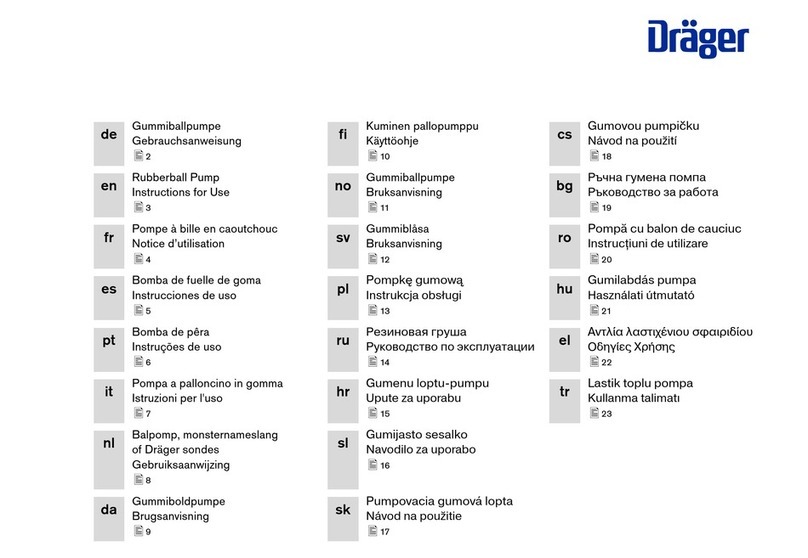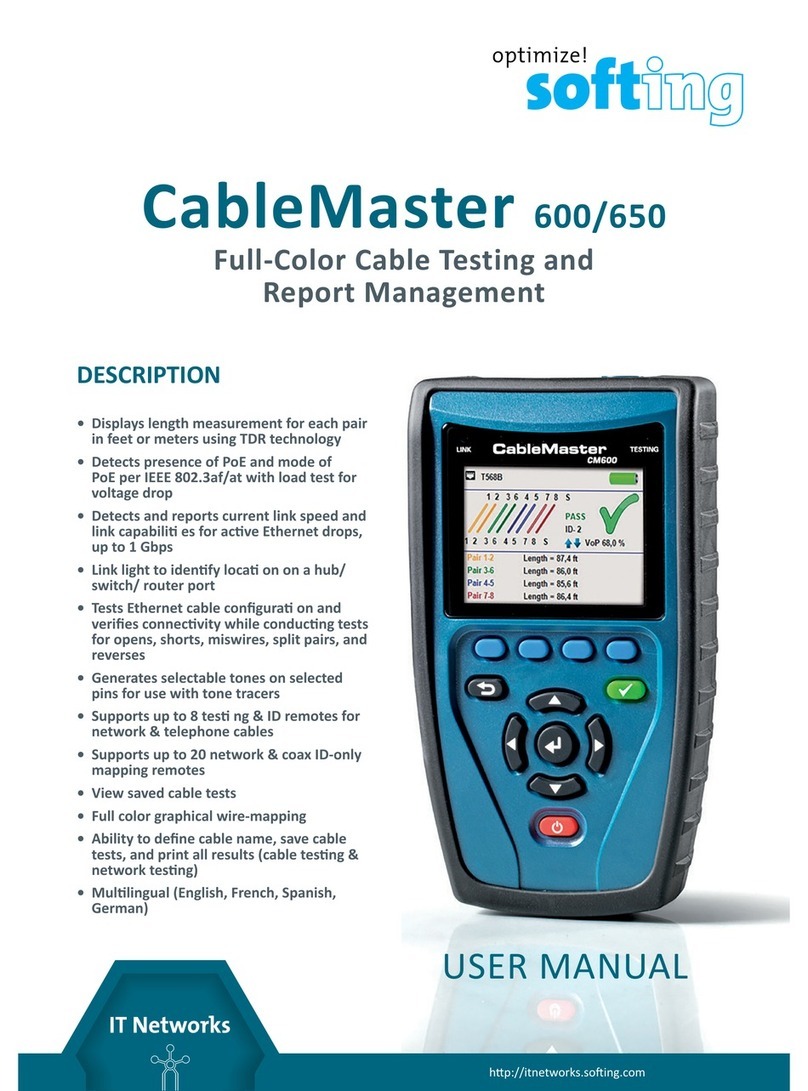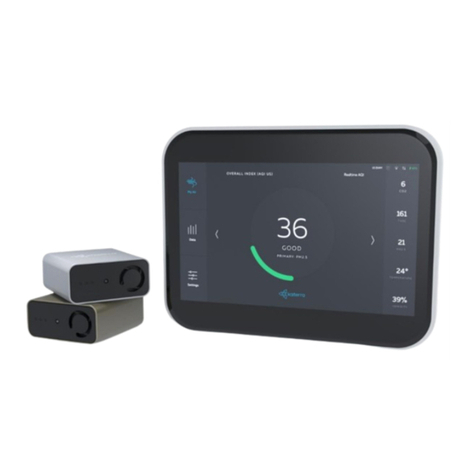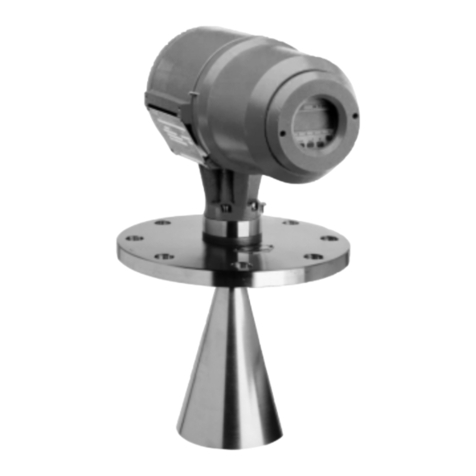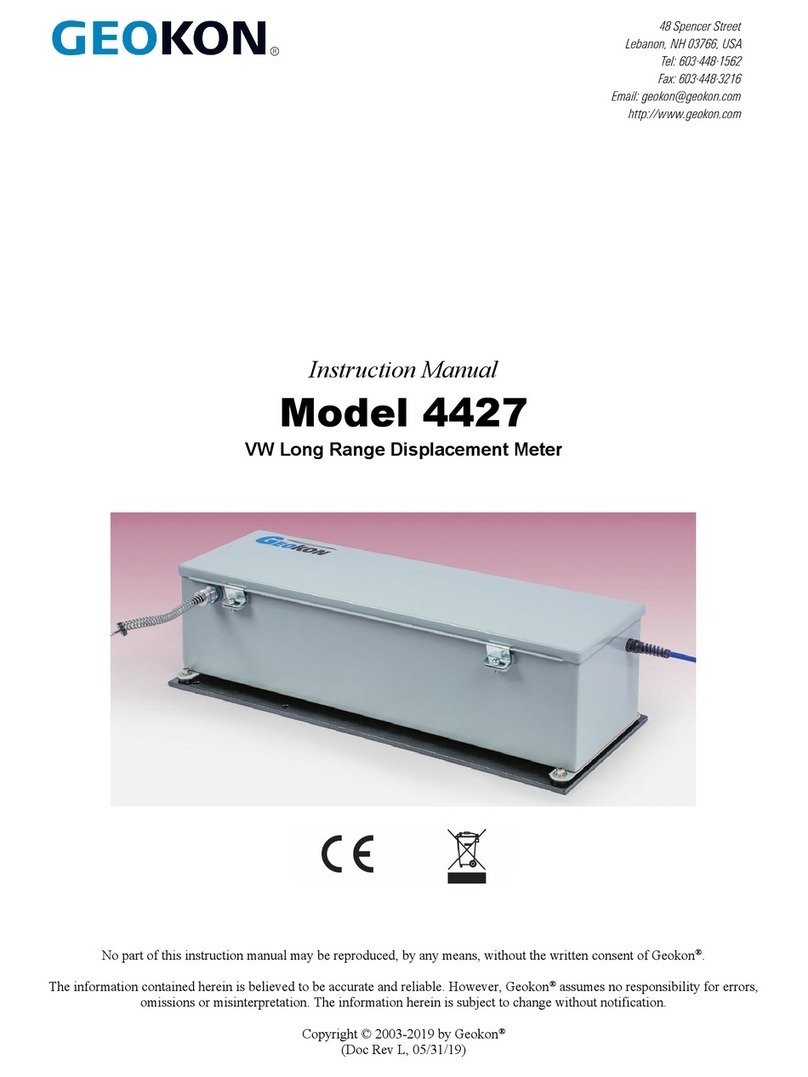ROM Elektronik HFA-3 User manual

ROM-Elektronik GmbH
elektronik
µ
RF-Analyzer HFA-3
Manual

Seite 2
ROM-Elektronik GmbH
Many thanks for deciding on the purchase of this device.
You are now able to determine the high-frequency situation quickly and
simply, and carry out a simple selection of the frequency ranges (as it were,
a simplified RF spectral analysis).
Reference: In case of the mobile communications frequency ranges
GSM900, GSM1800 and 3G (UMTS) of our HFA-3, ONLY the so-called Down-
link is measured; therefore the frequencies of the base stations! A mobile
communications telephone can be measured in the operating mode
"All-pass", since the frequency range (GSM900, GSM1800 or 3G (UMTS)) is
generally known in this case.
The operation of the HFA-3 is simple. We have given this the highest priority
value!
Through our long-standing experience in RF measuring device construc-
tion, with support from the University of the German Armed Forces, Munich,
our "large" HF Measuring Unit PDM-3 and its "little brother" HFR-2, as well as
our multifrequency filter MFF-1, have undergone some decisive improve-
ments. Only by means of this (expensive) development effort, could we
also realize many of these improvements for the HFA-3.
The HFA-3 is a broadband receiver for the verification and evaluation of
high-frequency signals (mobile telephones C-Net, GSM900, GSM1800,
cordless telephones (DECT, CT1+ ...), radio and television transmitters,
microwave cookers ...).
The built-in peak value recording allows the measurement of pulsed RF si-
gnals according to building-biology requirements.
The sensitivity and gauging accuracy has been further increased in com-
parison with the HFR-2. On the LC display of the conveniently handled de-
vice, the electrical field strength can be read off directly in mV/m or the
radiant flux density in µW/m
2
.
The indicated values agree in a range ±3 dB in case of approx. 1 GHz (1000
MHz, GSM900 area) and direction of the antenna in the plane of polariza-
tion.
Over the switchable internal loudspeaker, the modulation of the radio fre-
quency signals can be made audible (e.g. pulsed RF radiation).
The direction and the polarization of the RF radiation can be determined
simply by the attachable, logarithmic-periodic broadband antenna inclu-
ded in the scope of delivery, (logper antenna).

Seite 50
ROM-Elektronik GmbH
T
ips and notes on frequently asked questions
Avoid the operation of a mobile telephone (cell phone) in direct proximity
to the HFA-3! Never allow the antennae of the HFA-3 and mobile telepho-
ne to come in contact during operation!
DANGER OF DESTRUCTION
!
In case of the peak value recording, it takes a certain time until the mea-
sured value has adapted; in particular downwards. The reason for this is
that the measured values are stored and a certain time passes (approx. 30
sec) until this storage is emptied. Also, the display becomes very unstable
if pulsed signals are registered.
The measurements of the long-term recording are always stored on the
hard disk TO AVOID DATA LOSS!
~H0000.TMP: Header file
~A0000.TMP: Measurement file
In the case of a program crash, a valid file HFA-3 can be generated from
these files, where the following occur
• The program is newly started,
• The recording is set adjusted
•
in the menu: Recording\Save is selected with specification of a
name. This file can be again normally loaded with Recording\Open
and displayed as color graphics!
Technische Daten
Frequency range: ca. 100 MHz bis 2500 MHz
(Approx. 10 MHz to 3000 MHz with decreased precision)
Measuring range: 6 mV/m to 2000 mV/m (= ca. 0,1- 10000
µ
W/m
2
= 10 pW/cm
2
- 1
µ
W/cm
2
)
Max. sensitivity: Better than 0,01
µ
W/m
2
(= 1 pW/cm
2
)
Filter frequency ranges:
All-pass network, broadband (100 MHz to approx. 3 GHz)
GSM 900 (935 MHz to 960 MHz)
GSM 1800 (1805 MHz to 1880 MHz)
Cordless telephones according to DECT standard (1880 MHz to 1890 MHz)
3G (UMTS) (2110 MHz to 2170 MHz)
WLAN, Bluetooth, microwave oven (2400 MHz to 2500 MHz)
Display: LC-Display, 2 lines
Ambient temperature: 0 to 40˚C
Dimensions: 85mm x 117mm x 55mm
Functions: Adjustable volume
Weight: Approx. 300 g
Power supply: 9V block battery
Current consumption: max. 20 mA
Scope of delivery: HFA-3, Logper-Antenna 900MHz - 2600 MHz, Battery
Also optionally available with serial computer interface and recorder outlet
Seite 3
ROM-Elektronik GmbH
Preliminary notes - Notes on safety
You have acquired an electronic measuring device. Handle your HFA-3 ca-
refully! Due to the high level of sensitivity, the electronics of the measuring
device are sensitive to shocks and jolting. Please do not let it fall!
The antenna of the device conducts electric current very well. Do not bring
the antenna too near plug sockets, current-carrying cables or rigs! The
HFA-3 could be destroyed with contact of the antenna with current! Also
the electric shocking of the user cannot be entirely excluded!
The HFA-3 does not belong in children's hands! Although the device is quite
rugged, nevertheless the antenna can suffer damage in case of inappro-
priate use.
Never bring to the HFA-3 in contact with water! Do not use in the rain. The
sensitive electronics can be damaged.
Avoid high temperatures! The device should not be placed on heating units
or left in the car in summer under full sunlight!
Please note that the device uses a relatively large amount of current and
thus the battery can be used up fast. The HFA-3 signals a used battery in the
display with the message "Change battery". Rechargeable batteries can
also be employed.
The HFA-3 is maintenance-free. A re-calibration is not necessary! Clean the
device only on its exterior with a moist cloth. Do not use any cleaning
agents!

Seite 4
ROM-Elektronik GmbH
Operational startup
If not already carried out, insert a 9 V battery (or rechargeable battery)
into the battery compartment on the reverse side.
Screw the supplied logper antenna onto the HFA-3 where appropriate,
tighten with a tool.
Installation of the antenna with tuning assistance
Seite 49
ROM-Elektronik GmbH
Liability and guarantee
Every liability which arises from application of the device is excluded. The
guarantee period is 24 months from delivery date. Within this time, all de-
ficiencies, which are not attributed to inappropriate treatment, are repaired
immediately and clear of all charges. In case of repair being necessary,
please send the device to us with the proof of purchase.
Assistance and support
Should you require assistance in the application of the device, then you can
reach us under Fax No.: 08282-7305 or Tel.: 08282-7385 with operational que-
stions concerning the device.

Seite 48
ROM-Elektronik GmbH
Setting adjustment of the correct baud rate
If, contrary to expectation, only unreadable "hieroglyphs" should appear
on the PC, this can be attributed to a slightly deviating baud rate of PC
and HFA-3.
In this case, the HFA-3 can be re-calibrated. For this, the left-hand and
right-hand pushbuttons are to be pressed SIMULTANEOUSLY with switching
on. A signal appears on the display as follows:
after a pause followed by
Where the number in the second line decreases continuously.The following
should be observed on the screen terminal.
If the text "Wait until it can be read ... then press x" can be read off without
error, then please activate the key "X" on the PC keyboard. The correct
baud rate is now set adjusted and stored permanently.
This procedure can be repeated as often as necessary.
Screen for baud rate calibration
OscCal: 7E
EEPROM: 126
Kalibrier-
wert:
63H
Seite 5
ROM-Elektronik GmbH
Switch on the HFA-3 with the slide switch located on the side.
The following message should appear shortly on the display:
then e.g.
With this, your HFA-3 is in operation.
Built-in loudspeaker
A volume control is located on the front panel of the HFA-3. The volume of
the built-in loudspeaker can be adjusted here and/or optionally using plug-
ged-in headphones.
The loudspeaker reproduces the modulation signals which are received
Operator elements of the HFA-3
Volume for built-in
loudspeaker and
optional
headphone
Switch
On
Off
Antenna connector
Headphone
plug Batterycase at
the backside
Pushbuttons
ROM-Elektr.
HFA-3 V2.0
65.4 mV/m
¥¥¥¥¥¥¢

Seite 6
ROM-Elektronik GmbH
over the antenna. Do not be surprised when you hear the signals for the first
time. Here you get an impression that signals are in the "ether" that you do
not notice because none of your senses is able to register these.
A signal which is simple to identify is that of a DECT cordless telephone. The
base station constantly sends a 100 Hz tone whether telephoning or not! As
soon as the power plug is pulled on the base station, the hum tone disap-
pears.
Mobile telephones (cells), which communicate according to the GSM
standard, send a 217 Hz signal. However, this is sent only during telephon-
ing. The corresponding base stations, on the other hand, can be identified
through a high whistling tone with approx. 1733 Hz (8x217 Hz =1733 Hz).
Radar systems send signals from 600 Hz to 1200 Hz.
There are innumerable other, in-part "exotic" signals, which cannot all be
counted here. With time, you will gain your own experience.
Functions
The HFA-3 has a built-in filter bank in order to carry out the measurement for
individual frequency ranges only. The filters are set adjusted to fixed fre-
quencies. In the measurable frequency range, the 3 bands of the mobile
communications are offered (GSM900, GSM1800, 3G (UMTS)), cordless te-
lephones (DECT) and the services employed for computer networking,
such as WLAN and Bluetooth.
The pushbuttons located on the front side are employed to alternate bet-
Frequency designation Frequenzbereich
All-pass network (no filter) 10 MHz to approx. 2500 MHz
GSM900 935 MHz to 960 MHz
GSM1800 1805 MHz to 1880 MHz
DECT (Digital Enhanced Cordless Telephone) 1880 MHz to 1890 MHz
3G (UMTS) 2110 MHz to 2170 MHz
WLAN, Bluetooth, Mikrowellenherde 2400 MHz to 2500 MHz
Designation and frequency range of the frequency filter of the HFA-3
Situation of the frequency filters on the HFA-3
Seite 47
ROM-Elektronik GmbH
After a click on OK, the first data can be sent to the PC.
If everything has proceeded successfully, data should now appear conti-
nuously on the screen in similar form as represented above. If a filter is selec-
ted, this is output behind the measured value.
Select 2400 baud, 8 databits, 1 stopbit, no parity
Data output of the HFA-3

Seite 46
ROM-Elektronik GmbH
The interface must be set adjusted to 2400 baud 8N1!
Attach a new connection
Select a free serial interface
Seite 7
ROM-Elektronik GmbH
ween the different functions of the HFA-3.
Frequency filters
The individual frequency ranges are selected with the right-hand pushbut-
ton (RT). Simply activate the pushbutton until the required symbol for the fre-
quency range is indicated in the display.
Table of the function on activating the pushbuttons
left
pushbutton
right
pushbutton Function
push Peak value storage (PeakHold) On/Off switching
push RF filter stored cyclically at every actuation
push and hold then push Branching off in main menu
push in main menu Selection between display or menu data logger
push in main menu Branch between mV/m and µW/m2
push in display menu Selection between mV/m and µW/m2
push in display menu Return to the normal operation indication
push in data logger
menu Set or delete dataLog and/or cyclical flag
push in data logger
menu Return to the normal operation indication
Symbol In the display Meaning
DD
DD
Filter for GSM900 (935 MHz to 960 MHz) active
EE
EE
Filter for GSM1800 (1805 MHz to 1880 MHz) active
dd
dd
Filter for DECT (1880 MHz to 1890 MHz) active
UU
UU
Filter for 3G (UMTS, 2110 MHz to 2170 MHz) active
WW
WW
Filter for WLAN (2400 MHz to 2500 MHz) active
Table 1:
Meaning of the symbols in the display
left pushbutton right pushbutton
65.4 mV/m D
¥¥¥¥¥¥¢
A „D“ signals
Filter für GSM900
active

Seite 8
ROM-Elektronik GmbH
Selection of the measurement unit
The HFA-3 is able to indicate the measured value either in units of electrical
field strength (mV/m) or in radiant flux density (µW/m
2
). The unit is changed
as follows:
Keep the left-hand pushbutton (LT) pressed and then press the right-hand
pushbutton (RT) until the following display appears.
Typical frequency response of the HFA-3
65.4 mV/m
¥¥¥¥¥¥¢
”Anzeige
DatenLogger
Seite 45
ROM-Elektronik GmbH
• The program is restarted,
• The recording is set adjusted
•in the menu: Recording\Save is selected with specification of a name.
This file can be normally loaded again with Recording\Open and dis-
played as color graphics!
In order to save the data on a PC (long-term recording), the HFA-3 is to be
connected with a free serial interface using the cable supplied (if option has
been ordered). If your PC does not have any serial interface, the connec-
tion can also be realized with a USB serial converter.
Serial RS232 data output (PC connection, alternative
method)
Below is described the procedure in example form for a Windows PC. A si-
milar procedure is possibly necessary for other computers. Where appro-
priate, inquire with your computer dealer or specialist.
Start the software "Hyper Terminal" on the PC (can be found in /Pro-
gram/Communication/Hyperterminal). After the start, the configuration is to
be carried out.
Display of recording, open recording

Seite 44
ROM-Elektronik GmbH
All specifications from the recording display are stored in an ASCII file (mo-
de, maximum values, recording beginning, recording duration, location
and comment).
The measurement curve is saved with time, measured value, filter and co-
lor code.
Thus it is possible to load an already implemented recording into the HFA3
1.0 again at a later time for viewing.
This comes about by clicking the icon Open (or in the menu) and by selec-
tion of a file name in the opening dialog window. The file is searched for
first in the Directory\Recording as a default.
The measurements are always saved on the hard disk IN ORDER TO AVOID
DATA LOSS!
~H0000.TMP: Header file
~A0000.TMP: Measurement file
In the case of a program crash, a valid file HFA-3 can be generated from
these files where
Display of recording, Save recording
Seite 9
ROM-Elektronik GmbH
With the left-hand pushbutton (LT), the selection is reached:
In the same way, you can skip back and forth between the units with the
left-hand pushbutton (LT). The arrow to the left near the unit identifies the sel-
ection. The selection is confirmed with the right-hand pushbutton (RT) and
the display changes into the display mode:
Configuration of the data logger
The HFA-3 is able to transmit measured values to a data logger connected
to the serial interface (e.g.: Uni MMC Data Logger I or our data logger that
is just being developed). The configuration of the device for operation with
a data logger is as follows:
In normal operation indication, hold the left-hand pushbutton (LT) pressed
and press the right-hand pushbutton (RT), then the following display ap-
pears.
Then selecting the data logger entry with the left-hand pushbutton (LT).
Through pressing the right-hand pushbutton (RT), change into the data log-
ger menu.
mV/m
”
µW/mˇ
65.4 µW/mˇ
¥¥¥¥¥¥¢
65.4 mV/m
¥¥¥¥¥¥¢
”Anzeige
DatenLogger
”
DatenLogger
Anzeige
zyklisch
”
DatenLog.

Seite 10
ROM-Elektronik GmbH
With every press on the left-hand pushbutton (LT), the arrow changes bet-
ween both options and the data logger (Data Log.) and the filter rotation
(cyclical) is activated or deactivated.Whether the data logger and/or the
filter rotation is activated can be identified on the "<" character at the end
of the word.
When "Data Log." is activated, all measured values with 4800 baud are
transferred to a connected data logger over the serial interface.
If "cyclical" is activated, the filters are additionally cyclically changed ac-
cording to 5 measured values in each case.
The selected adjustments remain until the switch-off of the device and are
deactivated automatically on restart.
With a press on the right-hand pushbutton (RT), you return to normal ope-
ration indication.
PeakHold
The HFR-4 has a peak-hold funcion. This funcion enables to „freeze“ the
measured value on the display. Therefore, it is necessary to push the left
button (LT) until the symbol for peak-hold appears.
With activated peak-hold, the value reading changes wehenever the
measured value is greater then stored value. The bargraph shows allways
the actual value (follows the actual reading)
Modulation
Radio frequency signals are difficult to measure, not only because of their
very different frequencies. A complicating factor is that there are also
many different modulation methods. The latest research results indicate
that the modulation method (e.g. pulse modulation) has a strong influ-
ence on the biological relevancy of a radio frequency signal.
Exactly as biological systems, the radiation detector also does not react si-
milarly to all modulation methods. The modulation of the RF signals can be
detected over the built-in loudspeaker.
zyklisch<
”
DatenLog.<
218 µW/mˇ^
¥¥¥£££
Symbol for
PeakHold
Seite 43
ROM-Elektronik GmbH
With a click on the Save command button (or in the menu) a recording can
be saved.
A dialog window is opened in this case, in which the file name for the recor-
ding and a memory location (path) for this file are entered. Standard me-
mory location is the Directory\Recording which is attached during the
installation.
Display indication: Power flux density S, Mode: automatic

Seite 42
ROM-Elektronik GmbH
The filter areas are color coded in the measurement curve (frequencies:
e.g. GSM900). The color codes are indicated near the text fields of the ma-
ximum values.
Below the text fields for the maximum values of the recording is the text
field in which the current measured value is indicated with regard to
amount and units.
Further displayed are the recording beginning (date, time) and the recor-
ding duration. These text fields are filled automatically on start of the mea-
surement.
Two information text fields are available for the optional storing of the re-
cording:
Location: Specifications of the point of measurement as a text field (text
length is limited!)
Comment: Memos for the measurement are entered here
The peak values of the recording for the individual filter adjustment are dis-
played in the text fields and in the diagram (frequency ranges: e.g.
GSM900), either for the field strength or the power flux density.
By clicking on the icon Mode Change, you can alternate between these
operating modes. With every change of mode, the displays and the dia-
gram are deleted and a new recording begun.
Especially helpful at this point is the automatic setting adjustment in the
mode display list. All filters (frequency bands) are then processed at inter-
vals of 8 seconds, one after each other. The measurement curve is further
traced according to the just processed filter (frequency range) in the assi-
gned color.
Reference: This adjustment functions only in case of on-going measure-
ment and always begins with the all-pass network filter (independent of
what was set adjusted prior to the start of the measurement.
The color codes (as in display indication) are as follows:
red Allpass
orange GSM900
yellow GSM1800
green DECT
blue 3G (3G (UMTS))
magenta WLAN
Seite 11
ROM-Elektronik GmbH
The HFA-3 has a fixed integrated peak value recording and displays the
non-pulsed value and pulsed value simultaneously in the display!
The problem of the peak value recording is the following: The measuring de-
vice requires a certain time for the measurement. The measuring device so-
metimes "checks" whether there is a measured value present. If this by
chance always occurs between the "check" pulses, then the measuring de-
vice displays a very low measured value. Nevertheless, now and then it cat-
ches a pulse and displays this as well. However, this happens much too
seldom.
The peak value recording "notices" a certain time for the peak value of the
pulse. Thus the opportunities for the measuring device to measure the cor-
rect peak value are greater. If the pulse width is very narrow (approx. 100 ns
= 100 nanoseconds = 100 billionths of a second with DECT), then, under cer-
tain circumstances, the "peak value storage" is not filled completely and the
measured value is a little too low. If the pulse lasts longer (>0.3µs, GSM ap-
prox. 577 µs), then the opportunities that the "peak value storage" is filled
completely increase, which again results in a correct measured value indi-
cation.
Difference between average value and peak value recording
65.4 µW/mˇ
¥¥¥£££
unpulsed content pulsed content

Seite 12
ROM-Elektronik GmbH
RF Basics
In case of high frequencies, electrical fields (E-fields) and magnetic fields
(H-fields) no longer exist independently of each other. They are both in a
fixed relationship and carry energy together. The radiant flux density S re-
sults from the energy that flows through a certain section area (m
2
) per unit
of time (sec).
S, E and H can be converted at any time
1
:
(GL 1)
and
(GL 2)
S: Radiant flux density [W/m
2
]
E: Electrical field strength [V/m]
H: Magnetic field strength [A/m]
It is therefore sufficient to measure one variable in order to be able to de-
termine all others as well. Very frequently it is the radiant flux density S that
is measured. Our HFA-3 measures the component of the electrical field
strength!
For the measurement, a suitable antenna is required, which absorbs a cer-
tain radiant flux density quantity with its effective surface A
w
and converts
it into a line-conducted wave. The power of this wave results from the radi-
ant flux density and the effective surface of the antenna:
(GL 3)
P
E
: Received power
A
w
:Effective surface of the antenna
S: Radiation flux density
1.Only valid in free space
SEH⋅E2
377Ω
------------- H2377Ω⋅== =
E
H
----377Ω=
PESA
W
⋅=
Seite 41
ROM-Elektronik GmbH
Recording
This display is used to enable the observation and saving of the time-related
progress or the fluctuations of the field strength and/or the power flux density
during a measurement.
The peak values of a measurement are recorded exclusively. The represen-
tation of the measured values is implemented in a logarithmic diagram over
time, after the measurement has been started. When the set-adjusted re-
cording width (see chapter on display list) is reached during the recording,
then the measurement curve scrolls automatically further. The correspon-
ding time markers are fixed at the left-hand and right-hand edge of the gra-
phics. The time difference between these time markers then corresponds
exactly to the recording width.
The recording ends when the set adjusted value of the recording duration is
reached (see chapter on display list).
The maximum values during a recording are indicated in separate text
fields, which are located at the right-hand edge of the display window.
Display indication: Power flux density S, Mode: manual

Seite 40
ROM-Elektronik GmbH
and begins always with the all-pass network filter (independent of what
was adjusted prior to the start of the measurement).
Display indication: Power flux density S, Mode: manual
Seite 13
ROM-Elektronik GmbH
The measuring range of the HFA-3 extends from approx. 6 mV/m to 2000
mV/m or from 0.1 µW/m
2
to 10,000 µW/m
2
. If higher levels should be mea-
sured, the measuring range can be adapted upwards through external at-
tenuators. There are attenuators available with 6 dB, 10 dB and 20 dB.
The most frequently required attenuators are those with 10 dB and 20 dB. If
e.g. you wish to extend the measuring range from the present 10 mW/m
2
to
1000 mW/m
2
(approx. 20V/m), you require the 20 dB attenuator (Factor
100).
If you wish 10,000 mW/m
2
(approx. 61V/m), then you must additionally em-
ploy the 10 dB attenuator (Factor 100 + Factor 10 = Factor 1000 = 30 dB)..
Attenuation factor for field
strength (mV/m)
Attenuation factor for power
(µW/m
2
)
6 dB 2 4
10 dB 3 10
20 dB 10 100
Table 2: Attenuation factors for available attenuators
Assembled attenuator
Attenuator

Seite 14
ROM-Elektronik GmbH
Included in the scope of delivery of the HFA-3 is a logarithmic- periodic an-
tenna (logper antenna) for the frequency range 900 MHz to 2.6 GHz, for fi-
nancial reasons in the form of a printed circuit board! With this, the
direction and polarization of the RF radiation can basically be exactly de-
termi-
ned.
Table 3: Conversion of the radiant flux density V/m and A/m
S in mW/m
2
S in µW/cm
2
E in V/m H in A/m H in mA/m
200 20 8,68 0,023 23,03
100 10 6,14 0,016 16,29
50 5 4,34 0,012 11,52
20 2 2,75 0,007 7,28
S in µW/m
2
S in nW/cm
2
E in mV/m H in mA/m H in mA/m
Measuring range of the HFA-3
10000 1000 1940 0,005 5,15
5000 500 1370 0,004 3,64
2000 200 870 0,002 2,30
1000 100 614 1,629 1628,70
500 50 434 1,152 1151,60
200 20 274 0,728 728,36
100 10 194 0,515 515,03
50 5 137 0,364 364,18
20 2 86,8 0,230 230,33
10 1 61,4 0,163 162,87
5 0,5 43,4 0,115 115,16
2 0,2 27,5 0,073 72,84
1 0,1 19,4 0,052 51,50
0,5 0,05 13,7 0,036 36,42
0,2 0,02 8,6 0,023 23,03
0,1 0,01 6,1 0,016 16,29
Seite 39
ROM-Elektronik GmbH
ring the measurement in the individual filter areas (e.g. GSM900) either for
the field strength or the power flux density (click the icon Mode Change).
The displays are color coded:
.
It is particularly helpful at this point to automatically set adjust the mode in
the display list.All filters (frequency bands) are then processed at intervals of
8 seconds, one after each other.
Reference: This adjustment functions only in case of on-going measurement
Readings: green Fieldstrength E in V/m
red Radiant flux density S in µW/m2
Maxima: red Allpass
orange GSM900
yellow GSM1800
green DECT
blue 3G (3G (UMTS))
magenta WLAN
Anzeige Display, Feldstärke E, Modus: automatisch

Seite 38
ROM-Elektronik GmbH
In addition, the transmission rate of the RF sensor on the PC is indicated in
the field Settings, as well as the transmission time that is written during the
measurement.
Reference 1: The mode change from field strength to power flux density,
as well as the setting adjustment of the filter (frequency range; e.g.
GSM900), has effect only if the measurement is already running.
Reference 2: It is possible in individual cases that the display of the average
value exceeds the display of the peak value. The average value is then li-
mited to the peak value in the text field Average Value.That is not the case
In the field Measured Values, because the values are indicated here as
they arrive.
Display
With this display, the measured values from the RF sensor are displayed in
large text fields, which can still be read at some distance from the PC.
A small terminal field is available in the left upper edge, which records the
successful run of a measurement as a status window.
The transmission time is displayed near this.
In the text fields are displayed all measured values and their maximums du-
Terminal display
Seite 15
ROM-Elektronik GmbH
A logper antenna consists of several dipoles of different lengths. Every rod
pair receives a different frequency. The long rods are responsible for the low
frequencies (larger wavelength) and the short rods for the high frequencies
(smaller wavelength). Wavelength and frequency have the following relati-
onship to each other:
(GL 4)
λ
:Wavelength
c
0
:Velocity of light (=300,000 km/s)
f: Frequency
With the HFA-3 the electrical field strength E can be measured in mV/m and
the radiant flux density S in µW/m
2
and converted back and forth with the
formula (3). Prerequisite, however, is that the effective surface area of the
antenna is known.
The effective surface area is not constant, however, but dependent on fre-
quency:
(GL 5)
G: Antenna gain (= amplification; frequency-dependent)
λ:Wavelength
c0:Velocity of light
f: Frequency
c0λf⋅=
AWGλ2
4π
------
⋅Gco
2
4πf
---------
⋅==

Seite 16
ROM-Elektronik GmbH
In order to be able to determine the radiant flux density exactly with Equa-
tions (3) and (5), you must measure not only the received power, but you
must also determine the frequency. For this, spectrum analyzers are gene-
rally used, which are very expensive because of their complicated struc-
ture.
If it is a question of the effect of electromagnetic waves on persons, howe-
ver, the radiant flux density generally does not have to be determined ex-
actly. Here it is of primary importance to know the order of magnitude of
the radiant flux density, in order to make a judgment of the potential dan-
ger. The RF analyzer HFA-3 has been developed for this purpose. It consists
of a very sensitive RF power measuring device (detector). Since the detec-
tor cannot determine the frequency of the radio frequency radiation, no
high-precision measurements are possible with it for the above explained
reasons.
Uncertainties of measurement
From the above-mentioned facts, it can be identifiable that, with the mea-
surement of the radio frequency, uncertainties of measurement (measu-
ring errors) must be expected.
Which order of magnitude of the measuring errors must be dealt with? If
we look at the best RF measuring devices which can be bought, they most-
ly have an uncertainty of measurement of ±3 dB. In the measuring of out-
put, 3 dB means a factor of 2! For the measured value, this means that the
true value or can be twice as large or only half the indicated value. Expres-
sed in percent, we therefore have an uncertainty of measurement of ±50%
with a very good measuring device!
In case of more economical devices, these measuring errors are often far
greater. However, what is the situation with the HFA-3? We must consider
the inadequacies of the antenna and the measuring device. This is becau-
se the combination of the two of them should supply the "correct" measu-
red value.
A high level of linearity is necessary for the measuring device (in order to
keep the measuring error low). High-frequency amplifiers generally have a
more or less linear frequency response. Without special measures, this un-
suitable characteristic can affect the overall linearity.
Only by means of large-scale development efforts and with close coope-
ration and support through the University of the German Armed Forces,
Munich, could a suitable radio frequency circuit finally be developed,
which does not indicate the disadvantages mentioned.The results of these
efforts are represented in the following graphics.
In order to achieve a corresponding sensitivity, antennae are required
which supply a sufficient outlet voltage in a large frequency range. Log-
arithmic-periodic antennae are very well suited for this. Therefore this an-
Seite 37
ROM-Elektronik GmbH
Terminal
With this display, the outputs peak value and average value are displayed
both with regard to amount and with the respective dimension. The values
are displayed as they come over the interface ("endless loop" in the measu-
ring device). A clock cycle is not available.
As soon as the measurement is started (click on the icon Start Measurement,
or out of the menu) the read-out values are represented in the text field
Measured Values under each other, where the peak value and average
value alternate.
The last measured values in each case are represented for diagnostic pur-
poses in the separate text fields Peak Value and Average Value in a larger
font.
The filter (frequencies) in the selection list can be adju-
sted manually or automatically. The maximum values
for every filter range are evaluated and can be stored
during the stored long-term measurement.
Selection list: Filter
In this selection list are listed the available recording
duration for the long-term recording. When the adju-
sted time has expired, the measurement is ended au-
tomatically
Selection list: Recording duration
In this selection list are listed the two possible recording
widths. The recording width is the time, which is repre-
sented as maximal during the long-term recording. If
the recording duration exceeds the recording width,
the graphics are scrolled automatically. The recording
width is stored with that i.e. if a measurement is loaded
again, only so much of the measurement curve is re-
presented that fits into the recording width. The remai-
ning part of the measurement curve is made visible by
shift of the horizontal scroll bar ("scrolled").
Selection list: Recording width

Seite 36
ROM-Elektronik GmbH
Selection list.
Alternatively, a measurement can be ended by
clicking this icon.
The change of mode is possible only by clicking the
icon
Auswahlliste
In case of most computers, the serial interface is con-
nected with COM1. If the HFA-3 does not function with
COM1, another port should be selected from the list of
available COM ports. The program determines all con-
nections available on your system. It is also possible to
connect the HFA-3 to the computer by means of a
USB-serial converter. USB ports are also displayed in the
selection list as COM.
Selection list: COM port
The presetting is manual, i.e. during a measurement,
the filter must be adjusted manually. With automatic
adjustment, the filters are incremented every 8 secon-
ds. In this way, the measurement is evaluated with only
one click in all filter areas and the maximum values de-
termined. In case of the long-term recording, the cha-
racteristic plot the maximum value is additionally
recorded as a function of the filter areas. The filter are-
as are encoded in color.
Selection list: Mode
Seite 17
ROM-Elektronik GmbH
tenna is also included in the scope of delivery of the HFA-3.
However, these have the disadvantage that their outlet voltage decreases
with the square of the frequency. In case of measurement with a spectrum
analyzer, the fault arising from that can be calculated from the result of
measurement, since the frequencies of the measured signals are known. In
case of a broadband measuring device, such as the HFA-3, on the other
hand, the fault must be taken into consideration. The following graphics in-
dicate the error curve.
A good feature can be identified, in that the uncertainty of measurement is
within the mentioned ±3dB in the frequency range from approx. 900 MHz to
approx. 2500 MHz. This means that GSM900 and cordless telephone CT1+
Linearity characteristic of the input amplifier circuit of the HFA-3
Uncertanty of HFA-3

Seite 18
ROM-Elektronik GmbH
are registered correctly. When we consider the frequency range 600 MHz
to 2600 MHz, the uncertainty of measurement is still within ±6dB. In practice
this means that, in all-pass operation (= broadband), 3G (UMTS) and WLAN
signals can be somewhat undervalued, therefore a measured value is dis-
played which is too small.
We can counter this situation through the use of the built-in filters! The HFR-3
has frequency-specific calibration factors for every filter. Through this, it is
possible to consider an individual calibration factor in operation with selec-
ted filter, which influences the entire frequency response.
In other words: As is clear from the above graphics, the sensitivity decrea-
ses somewhat in all-pass operation (red curve) in the WLAN frequency ran-
ge. If the filter is now switched on for WLAN, the actual, true measured
value is displayed, which can be significantly above the value that was de-
termined in all-pass operation.
Do not be surprised if, for example, you measure a pure WLAN signal and,
in case of activated WLAN filter, a higher measured value is displayed than
in all-pass operation. A similar effect can possibly also be observed with
DECT and 3G (UMTS) signals.
Reverse attenuation
Reverse attenuation is indicated for every filter, with reference to the trans-
mission loss.
The reverse attenuation thus indicates how frequencies are strongly sup-
pressed, at least outside of the pass band.
For example, the damping of the GSM900 filter is 64 dB in the pass band
and 35 dB in the reverse attenuation range. Frequencies in the reverse at-
tenuation range are therefore decreased by 29 dB more than in the pass
range. The reverse attenuation is 29 dB.
The reverse attenuation applies for frequencies with sufficient separation
from the respective mobile communications frequency range.
Table 4 shows typical reverse attenuations of the filter up to 2.5 GHz. The
Filter
Reverse
attenuation
Elec. field strength
remaining display
Power flux density
remaining display
At least At most At most
GSM900 29dB 3,5% 0,13%
GSM1800 34dB 2,0% 0,04%
DECT 40dB 1,0% 0,01%
3G (UMTS) 16dB 15,8% 2,51%
WLAN 24dB 6,3% 0,40%
Table 4: Reverse attenuation of the filters to 2.5 GHz
Seite 35
ROM-Elektronik GmbH
now be saved (see later).
Change of mode: It is possibly to carry out a "change of mode" from field
strength to power flux density and vice versa, only during an on-going mea-
surement. The programming of the HFA3 measuring device requires this. For
this, it should also be ensured through the user that the measuring device is
in Mode E (field strength, display V/m) before the first measurement with the
HFA3 1.0 software.
Reference: Some adjustments in the menu bars or selection lists (e.g. filter,
automatic system mode) are effective only after the measurement has
been started.
Alternatively a measurement can be stored by klicking
this symbol. This symbol is only active in long term stora-
ge.
Alternatively a measurement can be opened by
klicking this symbol. This symbol is only active in long
term storage.
Menuleiste
Alternatively, the terminal display can be selected by
clicking this icon.
Alternatively, the indication display can be selected by
clicking this icon.
Alternatively, the recording display can be selected by
clicking this icon.
Alternatively, a measurement can be started by click-
ing this icon.

Seite 34
ROM-Elektronik GmbH
Recording:
The values have a clock cycle and are represented in this clock
cycle graphically. Long-term measurements are therefore possible. The
measured values can be stored and the stored measurements loaded
again (more on this later).
Recording only:
File options are possible for the long-term recording only.
Open:
Open a stored measurement and load into the recording window.
All long-term data, as well as the maximum values in the six different filter
ranges (e.g. GSM900, GSM1800, WLAN…), are displayed again.
Save:
Save the current long-term recording with all maximum values in the
filter ranges.
Deletion:
Deletion of the current long-term recording and all displays.
Measurement:
Change of mode and start/stop measurement are the ope-
rating options during the measurement procedure.
Start measurement:
The measurement is started and the measurement re-
presented in the display is selected beforehand.
Stop measurement: The measurement is stopped. The measurement can
Copy: the actual content of the displayed window will
be copied to the clipboard. With STRG+V it is possible
to paste this into your word processor software (i. e.
WORD).
Menuleiste: Bearbeiten
Terminal: Direct display of the raw infor-
mation from the HFA-3. The displayed in-
formation is time independent and shows
the values as it is received.
Display: display the readings with maxi-
mum and medial value as text with big
letters. The different frequency bands are
color coded.
Display: Terminal, display, recording are possible representations for the measuring
data from the RF sensor.
Seite 19
ROM-Elektronik GmbH
indicated values are "worst case values" and presuppose a sufficient sepa-
ration distance to the pass band (normally 10 dB to 20 dB). They do not ap-
ply for the mutual suppression of GSM1800 and DECT
Example:
The GSM900 filter has a minimum reverse attenuation of 29 dB. This means
that all frequencies outside of the pass band are decreased by at least 29
dB more strongly than GSM900 frequencies.
At an assumed point of measurement, GSM900- and GSM1800 frequencies
are present. In the case of the HFA-3, we set the filter to GSM900 (because
e.g. only GSM900 interests us)!
The influence of the E-field strength measurement values of the GSM1800
frequencies will then become noticeable with 3.5% of their initial value at
most. The correction of the display is already considered here. Assuming the
real field strength in the GSM1800 range is 1 V/m (mV/m =1000). Then the
remaining display amounts to only maximum 0.03 V/m (= 30 mV/m)!
If the measured value indication is employed for the power flux density, the
display of the GSM1800 frequencies is then reduced to 0.13%. With a power
flux density of 1 mW/m2(=1000 µW/m2), the remaining display is only 0.0013
mW/m2(=1.3 µW/m2).
The indicated values are the worst values up to 2.5 GHz. In most cases, the
suppression of the other mobile communications signals is still far better than
indicated here. This applies in particular for 3G (UMTS). The selectivity of the
filters, which is very high in most cases, also enables a measurement of cer-
tain mobile communications frequency ranges, if other mobile communica-
tions signals are far stronger.
In practice this means:
If, for example, the power flux density of the GSM1800 frequencies at a point
of measurement is 10 times stronger than the power flux density of the
GSM900 frequencies, in spite of this, the strength of the GSM900 frequencies
can be determined very exactly with utilization of the GSM900 filter.
DECT, GSM1800
GSM1800 and DECT frequencies are virtually seamlessly close to each
other. The selectivity of the filters is certainly good, but there are physical li-
mits. As can also be identified in the above graphics, the responses (green
and turquoise) of GSM1800 and DECT overlap a little. In practice e.g. in case
of selected GSM1800 filter, signals from a DECT base station located nearby
can also be measured and vice versa.

Seite 20
ROM-Elektronik GmbH
Polarisation
If we consider the electrical field component of an electromagnetic wave,
it is determined that this is in one plane. This plane is also designated as a
plane of polarization. The maximum measured value is provided in the
case where the receiving antenna points in the same direction and plane
as the transmitting antenna.
Measured value representation
In the display, the digital measured value is represented as a numerical va-
lue and the analog value measured value as a bar
Maximum measured value if transmitting and receiving antenna point in same
direction and polarization level.
65.4 µW/mˇ
¥¥¥¥¥¥¢
analog
digital
value
bargraph
Seite 33
ROM-Elektronik GmbH
Operating elements and displays
The operation of the HFA3 1.0 software is possible via the menu bar, com-
mand buttons and icons. Below are presented all operating elements
Menu bar, command buttons and icons
Statusleiste
Bedienelemente
Drucken:
Das aktuelle Anzeigefenster wird mit seinem
gesamten Inhalt an den installierten Drucker gesandt.
Beenden:
Alle Messungen werden angehalten und die
Software beendet.
Menuleiste: Datei
Anstelle des Menüeintrags bewirkt ein Klick auf dieses
Icon in der Schaltflächenleiste das Auslösen des Druck-
vorganges.
Anstelle des Menüeintrags bewirkt ein Klick auf dieses
Icon in der Schaltflächenleiste das Beenden des Pro-
gramms.
Menuleiste
Table of contents
Other ROM Elektronik Measuring Instrument manuals
Popular Measuring Instrument manuals by other brands
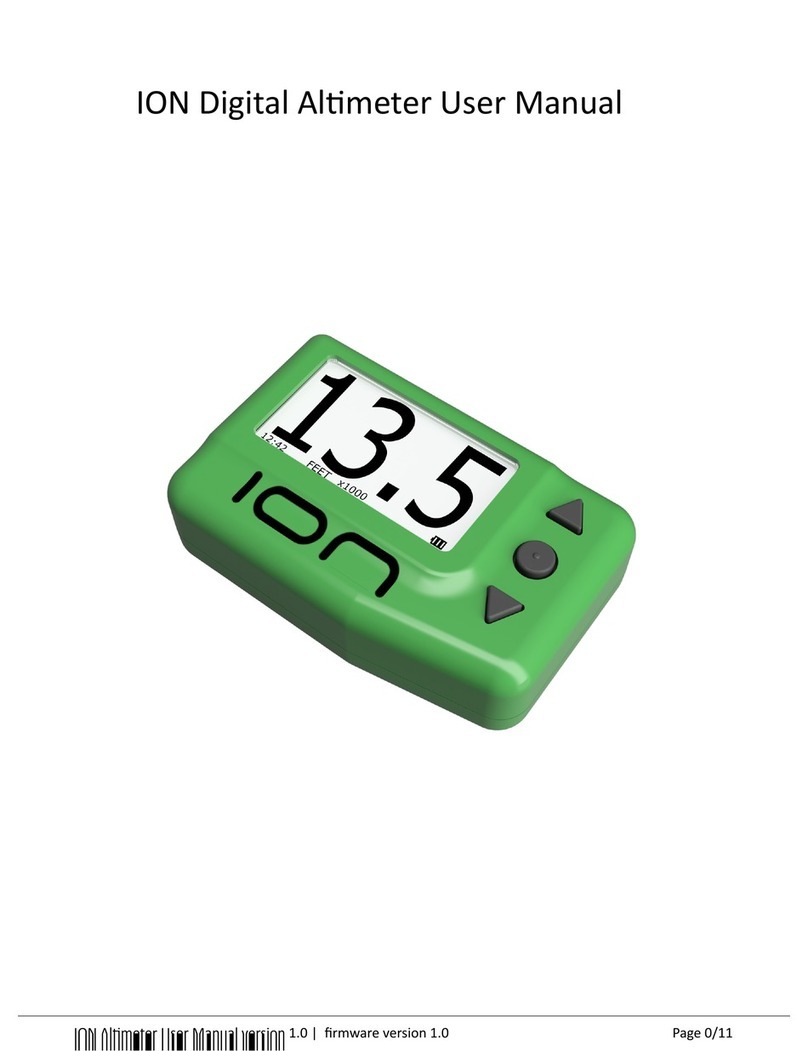
ION
ION DIGITAL ALTIMETER user manual
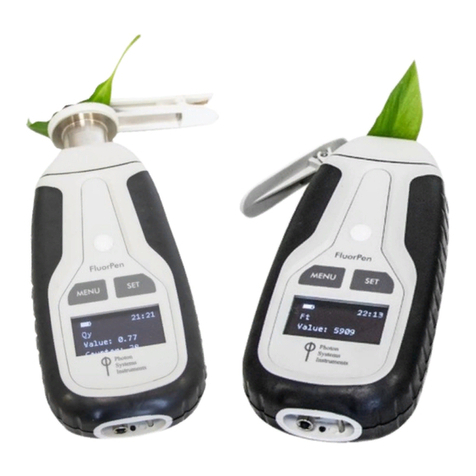
Photon Systems Instruments
Photon Systems Instruments FluorPen FP 110 Manual and user guide

Teledyne
Teledyne 730 Bubbler instruction manual
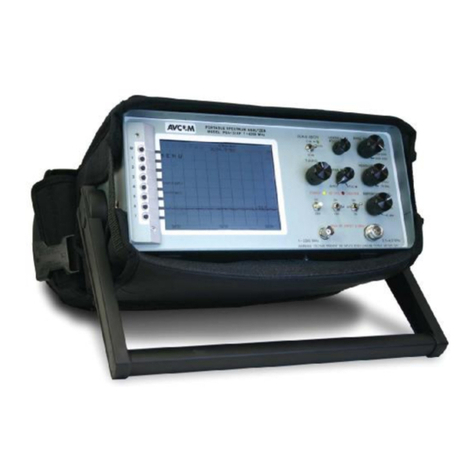
AVCOM
AVCOM PSA-37XP owner's manual

Biocare
Biocare Nuancer SR-III user manual
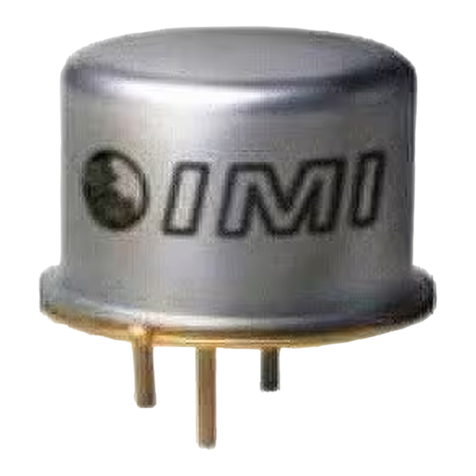
PCB Piezotronics
PCB Piezotronics IMI SENSORS 66392CPZ1 Installation and operating manual
